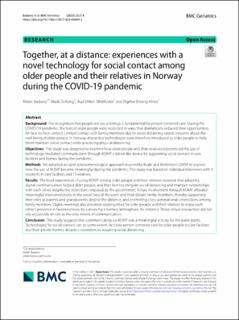| dc.contributor.author | Badawy, Abeer | |
| dc.contributor.author | Solberg, Mads | |
| dc.contributor.author | Obstfelder, Aud Uhlen | |
| dc.contributor.author | Alnes, Rigmor Grete Einang | |
| dc.date.accessioned | 2023-09-18T07:47:12Z | |
| dc.date.available | 2023-09-18T07:47:12Z | |
| dc.date.created | 2023-04-19T09:11:45Z | |
| dc.date.issued | 2023 | |
| dc.identifier.issn | 1471-2318 | |
| dc.identifier.uri | https://hdl.handle.net/11250/3089981 | |
| dc.description.abstract | Background
The recognition that people are social beings is fundamental for person-centered care. During the COVID-19 pandemic, the lives of older people were restricted in ways that dramatically reduced their opportunities for face-to-face contact. Limited contact with family members due to social distancing raised concerns about the well-being of older people. In Norway, interactive technologies were therefore introduced to older people to help them maintain social contact while practicing physical distancing.
Objectives
This study was designed to examine how older people and their relatives experienced the use of technology-mediated communication through KOMP, a tablet-like device for supporting social contact in care facilities and homes during the pandemic.
Methods
We adopted an open phenomenological approach inspired by Kvale and Brinkmann (2009) to explore how the use of KOMP became meaningful during the pandemic. The study was based on individual interviews with 4 residents in care facilities and 13 relatives.
Results
The lived experiences of using KOMP among older people and their relatives revealed that adopting digital communication helped older people, and their families mitigate social distancing and maintain relationships with each other, despite the restrictions imposed by the government. Virtual involvement through KOMP afforded meaningful interconnections in the social lives of the users and their distant family members, thereby supporting their roles as parents and grandparents despite the distance, and promoting cross-generational connections among family members. Digital meetings also provided opportunities for older people and their relatives to enjoy each other’s presence in favored places, by conveying a homely atmosphere, for instance. These virtual encounters did not rely exclusively on talk as the only means of communication.
Conclusion
This study suggests that communicating via KOMP was a meaningful activity for the participants. Technologies for social contact can, to some extent, facilitate person-centered care for older people in care facilities and their private homes, despite circumstances requiring social distancing. | en_US |
| dc.language.iso | eng | en_US |
| dc.publisher | BioMed Central | en_US |
| dc.rights | Navngivelse 4.0 Internasjonal | * |
| dc.rights.uri | http://creativecommons.org/licenses/by/4.0/deed.no | * |
| dc.title | Together, at a distance: experiences with a novel technology for social contact among older people and their relatives in Norway during the COVID-19 pandemic | en_US |
| dc.title.alternative | Together, at a distance: experiences with a novel technology for social contact among older people and their relatives in Norway during the COVID-19 pandemic | en_US |
| dc.type | Peer reviewed | en_US |
| dc.type | Journal article | en_US |
| dc.description.version | publishedVersion | en_US |
| dc.source.volume | 23 | en_US |
| dc.source.journal | BMC Geriatrics | en_US |
| dc.source.issue | 1 | en_US |
| dc.identifier.doi | 10.1186/s12877-023-03869-3 | |
| dc.identifier.cristin | 2141741 | |
| cristin.ispublished | true | |
| cristin.fulltext | original | |
| cristin.qualitycode | 1 | |

